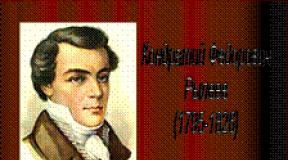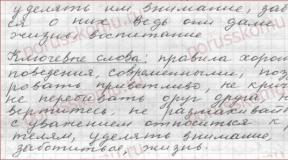How to correctly fill out the kudir for individual entrepreneurs on the usn “income. A universal report for checking labor costs in the income and expense ledger So, a few key points
The ledger for accounting income and expenses is an important tax register used to record business transactions and determine the result of the business activity of a simplifier.
After reading this article, you:
- learn how to use the Universal Report to check the correctness of filling out labor costs, taxes and contributions and determine what actions need to be taken so that these costs are reflected in the KUDiR;
- receive a link to a ready-made setup to use in your program.
Error filling in expenses in KUDiR remuneration
The 1C program supports automatic completion of the report Book of income and expenses of the simplified tax system : chapter Reports - simplified tax system - book of income and expenses of the simplified tax system. Sometimes a situation arises when the data in the report is filled in incorrectly, information is missing or is reflected incorrectly. At the same time, the report does not provide any “explanations”, and it is completely unclear where to look for the error.
To check the data on unaccepted salary expenses, we will use the settings of the Universal report for the Expenses under the simplified tax system register.
Setting up a Universal Report
The universal report in the program is located in the section Reports - Standard reports - Universal report.
Filling out the report header
In the header of the report please indicate:
- Period- period for compiling the report;
- Accumulation register - type of data source;
- Expenses under the simplified tax system - name of the register in which data on the acceptance of expenses of the simplified tax system is stored;
- Balances and turnover - register data Expenses under the simplified tax system .
Report setup
Open the report settings using the button Settings. Select View - Advanced.

For report Checking the inclusion of labor costs, taxes and contributions to KUDiR fill in the tabs:
- Selections ;
- Fields and sorting ;
- Structure .
Tackles tab
On the tab Selections by button Add selection please indicate:
- 1st line:
- Field - Type of consumption, Condition - On the list, Meaning - Salary; Taxes (contributions).

By button Show select the show command In the header of the report.

Completed tab Selections as follows:

Fields and sorting tab
On the tab Fields and sorting in addition to the default button indicators Add set the following indicator:
- Registrar .

Use the up and down arrows to arrange the fields in order. For a more compact report form, leave the checkboxes only on the following indicators:
- Reflection in NU;
- Registrar;
- Start amount remainder;
- Receipt amount;
- Amount of expense;
- Amount con. remainder .

In the window Sorting by button Add indicate the data ordering system in the report:
- Flow element -Ascending;
- Type of consumption -Ascending.

Structure tab
The initial report structure contains only detailed records. To build your own report structure, remove the default setting from the button Delete .
By button Add set the fields to be grouped as shown in the figure.

Generating a report
By button Form the report will be built according to the form specified by the settings.

Based on the report, we check the fulfillment of the conditions - salary:
- accrued;
- paid;
- accepted to NU.
As can be seen from the report, despite the fact that employee Kalinina S.V. wages were accrued and paid, the third condition for including the costs of paying wages in the expenses of the simplified tax system was not met: column Reflection in NU - Not accepted. The error lies in the information specified for Kalinina S.V. the method of reflecting salary expenses in the tax accounting system.


By changing Reflection in the simplified tax system and re-posting the accrual and payment documents, the report will generate the correct data:
- Reflection in the simplified tax system - Accepted.

Accordingly, the salary expenses of Kalinina S.V. will be reflected in KUDiR for 1 quarter. 2018
According to the reviewed report, it is easy to find the reason why labor costs, taxes and contributions are not included in KUDIR, and determine what needs to be done to correct the situation.
To avoid having to configure the report again each time, BukhExpert8 advises saving the settings in 1C using the button Save report option .
After entering the name of the setting, for example, Checking the inclusion of labor costs, taxes and contributions to KUDiR, you don't have to set up the report again every time. By button Select settings Just refer to the saved setting.

This article will focus on the specifics of filling out the KUDiR for entrepreneurs who have chosen the simplified tax system for income.
The filling principle is not complicated. There are only five sections in the book of accounting for income and expenses, of which the entrepreneur fills out the title page, the first and fourth sections on the simplified tax system for income.
Filling out the title page
The title page must reflect the year for which the book is being filled out, the date of completion, name, TIN, address and current account number. The object of taxation will simply be “income”. A completed sample title page is shown in the figure below.
Filling out the first section
Here you need to fill in income using the cash method. This means that income must be reflected in the book of income and expenses upon receipt of the entrepreneur’s current account or cash register. The receipt of money can be in the form of a payment order, strict reporting forms, or a Z-report.
You will need to fill out a form for each quarter. At the end of each table there is an amount for the quarter, and starting from the second quarter there is an additional line with the cumulative balance for half a year, nine months and a year.
So, first column is intended for the sequence number of the operation.
Second- date and number of the document according to which cash is received.
Third- a brief description of the operation, for which the money was received; if there is an agreement, then it can also be registered.
Fourth- the amount of receipt.
Fifth- we do not fill it out, since this column is for those who calculate the tax on the difference between income and expenses.
But, there are exceptions when you also need to fill out the fifth column on the simplified tax system for income.
If an entrepreneur received funds under programs to support the unemployed and support small businesses, then expenses and income must be reflected in one line, then they will be counted against each other and ultimately give zero, which will not affect the amount of tax in any way.
Sometimes it happens that you need to issue a refund. There are different situations - the product did not fit, a defect was discovered. In this case, in the income column we reflect the return amount with a minus.
A special feature for the simplified tax system for income when filling out this section is that you do not need to fill out a certificate for it, since it is intended for calculations using a different base.
For example, let's take the following conditions:
Individual Entrepreneur Tatyana Vasilievna Ivanova is an entrepreneur using the simplified tax system on income and is engaged in sewing curtains to order. In January, two orders were sent to a restaurant and a theater, costing 35,000 rubles and 25,000 rubles, respectively. Orders were paid on the 20th and 25th. At the end of the month, an error was discovered when laying out the fabric; less of it was used in the second order, and the cost was recalculated down by 1000 rubles. There is also one employee whose salary is 6,500 rubles, contributions to the pension are 1,430 rubles, to the FFOMS 331.50 rubles, and to the Social Insurance Fund 188.50 rubles.
The individual entrepreneur received a subsidy under the small business support program of 20,000 rubles and spent it on consumables. Let's fill out the first section.
Filling out the fourth section
Entrepreneurs who have chosen income as an object of taxation can reduce their tax by the amount of insurance premiums paid both for themselves and for their employees.
The fourth section is needed precisely to reflect these insurance premiums.
So, in the first column- serial number.
In the second- date and number of the document on which the transfers were made.
Third the column reflects the year for which contributions were transferred.
From fourth to ninth- the amount of insurance contributions to the pension fund, social insurance fund, health insurance fund, social insurance fund for accidents, social insurance fund for temporary disability, and under voluntary insurance contracts.
Tenth- the total amount of insurance premiums paid.
In our example, the entrepreneur pays fixed payments for himself to the pension fund 23,400 rubles per year and the health insurance fund 4,590 rubles per year, as well as for his employee monthly to the pension fund 1,430 rubles, the health insurance fund 331.50 rubles and the social insurance fund 188, 50 rubles. Let's complete the fourth section.
- The base can only be reduced by the contributions paid.
- This applies only to those contributions accrued for the current period. That is, it is impossible to reduce the amount of contributions once overpaid.
- Contributions are taken only those accrued during the period of application of the simplified tax system.
- It is impossible to reduce the tax by more than 50% for individual entrepreneurs and organizations with hired employees. This limitation is established by law. But an individual entrepreneur without employees can reduce the entire amount of fixed payments for himself.
An individual entrepreneur can pay fixed payments either in the entire amount at once for the year or quarterly. They must be transferred before December 31 of the reporting year, and until April 1 of the following year - 1% of the amount of income exceeding 300,000 (that is, if the income was more than 300 thousand, the amount above this limit is taxed at a rate of 1%). Employees must pay contributions every month.
In our example, the entrepreneur pays fixed payments for himself in the amount of 23,400 rubles to the Pension Fund, 4,590 rubles to the Federal Compulsory Medical Insurance Fund for the entire year.
Let’s say an individual entrepreneur paid fixed payments quarterly, but there was no more income during the year. Then the table will reflect the following figures: 5850 rubles - payment to the Pension Fund for the quarter, 1147.5 rubles - payment to the FFOMS for the quarter. For your employee, 1,430 rubles - to the Pension Fund, 332.5 rubles - to the FFOMS, 188.5 rubles - to the Social Insurance Fund monthly.
KUDIR is a book of income and expenses that must be maintained by all organizations and individual entrepreneurs (Article 346.24 of the Tax Code of the Russian Federation). There is no need to certify the book with the tax office, however, in case of any questions regarding the annual declaration, tax authorities can request the accounting book for a more thorough check. Errors in KUDIR or its absence are grounds for a fine of at least 10 thousand rubles (Article 120 of the Tax Code of the Russian Federation and Article 15.11 of the Administrative Code).
KUDIR is maintained according to the form approved by order of the Ministry of Finance of the Russian Federation dated October 22, 2012 No. 135n. KUDIR for individual entrepreneurs on the simplified tax system is the main tax accounting document. Simplified organizations, in addition to tax accounting in KUDIR, also maintain mandatory accounting. Taxpayers determine their tax base for the simplified tax on the basis of KUDIR, so if you combine several tax regimes, then you need to keep records of income and expenses under the simplified tax system separately from the other tax regime.
The general rules for registering and filling out KUDIR are as follows:
- for each tax period (that is, calendar year) - a new KUDIR;
- entries in the book are kept cumulatively in chronological order;
- KUDIR is filled out using the cash method, that is, only the actual movement of money in the cash register or in the current account is taken into account. If you have only shipped the goods to the buyer, but have not received payment, this is not yet recognized as income for the cash method of accounting. Similar rules apply for expenses;
- KUDIR is maintained on a computer, in a special accounting program or by hand;
- amounts are entered into the book in rubles and kopecks;
- the electronic KUDIR is printed at the end of the tax period;
- a printed electronic KUDIR or a handwritten paper one must be numbered, laced, sealed with the signature of the manager or the individual entrepreneur himself and a seal (if any);
- in a handwritten KUDIR, errors are corrected as follows: the incorrect entry is crossed out, the correct wording is written next to it, certified by the position, full name and signature of the person responsible, and the date the correction was made is recorded.
KUDIR consists of 4 sections plus a title page. In section I of the book, the taxpayer indicates income and expenses, in section II - expenses for the purchase of fixed assets and intangible assets, section III includes losses from previous years, by which the current tax can be reduced, section IV is devoted to expenses that reduce the amount of tax. Sections II-III should be filled out only for the simplified taxation system Income minus expenses, and section IV is intended only for the simplified taxation system Income. Let's take a closer look at how to conduct KUDIR with simplified taxation system of 15% and 6%.
Please note that changes to KUDIR, approved by order of the Ministry of Finance of Russia dated December 7, 2016 No. 227n, become effective only from January 1, 2018. In 2017, the income book is filled out in exactly the same way as last year.
Filling out KUDIR under the simplified tax system Income
Since the taxpayer uses the simplified tax system for income only to take into account his own income, then in section I of KUDIR he will reflect only receipts to the current account or to the cash desk. At the same time, not any money received is taken into account as income for determining the tax base. According to Art. 346.15 of the Tax Code of the Russian Federation, the simplifier takes into account as income his revenue and non-operating income - rental of property and other income from Art. 250 Tax Code of the Russian Federation. The list of income that cannot be taken into account on the simplified tax system is given in articles 224, 251, 284 of the Tax Code of the Russian Federation.
This list is long, most of the income is very specific. Let us point out the most typical for the daily activities of most businessmen: money received from the Social Insurance Fund to reimburse the costs of child benefits and sick leave for employees, the return of advances or any overpaid amounts, the amount of loans received, or the return of a loan issued by the organization itself cannot be considered income.
Individual entrepreneurs have even more nuances when accounting for taxes on income received under the simplified system. The entrepreneur does not take into account in the KUDIR according to the simplified tax system his income as wages for hire, replenishment of the cash register of his own enterprise. The sale of property not used in business activities (for example, a car or apartment) is also not included in income when calculating the tax base.
How to conduct KUDIR with a simplified tax system of 6%? Income receipts are reflected by registering the PKO, payment order or bank statement. If revenue is deposited according to BSO, then one receipt order can be made for several forms, but provided that the forms were issued within one business day. If you need to reflect the return of money to the buyer in KUDIR, then this amount must be entered in the “income” column with a minus sign.
Another nuance of filling out KUDIR according to the simplified tax system for income is filling out section IV. Since the taxpayer can reduce the amount of tax on insurance premiums using the simplified tax system for income, the amount of these contributions should be reflected in section IV of the KUDIR. The book contains information about the payment document, the period for payment of contributions, the category of contributions and their amount. Entrepreneurs in this section indicate not only contributions for employees, but also their own pension and health insurance. Based on the results of each quarter, as well as half a year, 9 months and a calendar year, results are summed up.
Example of filling out KUDIR on the simplified tax system Income 6%
Individual entrepreneur I.M. Kuznetsov bought raw materials for the production of buns for 230,000 rubles on January 11, 2016 and sold 100 buns at a price of 20 rubles per piece. The buyer returned one bun to the entrepreneur due to broken packaging. In addition, IP Kuznetsov received an advance from the buyer in the amount of 10,000 rubles. Kuznetsov has one pastry chef whose salary is 30,000 rubles. For January 2016, Kuznetsov paid insurance premiums for the employee - 9,000 rubles.
Here is what a sample of filling out KUDIR for individual entrepreneurs on the simplified tax system of 6% looks like in this example.
.png)
Filling out KUDIR under the simplified tax system Income minus expenses
Income in KUDIR is reflected in the same way, regardless of the selected simplified tax system option. But expenses are reflected in section I only under the simplified tax system: Income minus expenses. The list of expenses that can be taken into account in KUDIR is in Appendix 2 to the order of the Ministry of Finance of the Russian Federation dated October 22, 2012 No. 135n and in Art. 346.16 Tax Code of the Russian Federation. Since expenses reduce the tax base under the simplified tax system, tax authorities carefully check the company’s expenses and regularly issue letters and explanations: which expenses can be taken into account and which cannot. The general principle is that expenses can be accepted only if they are economically justified, documented and will bring income to the taxpayer.
When calculating the single tax, the payer of the simplified tax system can take into account material costs, labor costs and compulsory social insurance of employees and some other expenses. Each listed category of costs has its own characteristics, for example, costs for the purchase of goods fall into KUDIR only after they directly entered the warehouse, were paid to the supplier and sold to the buyer. Insurance premiums for employees under the simplified tax system. Income minus expenses do not reduce the calculated tax itself, but are included in the tax base as expenses in full.
Please note that personal expenses of an individual entrepreneur on the simplified tax system. Income minus expenses not directly related to making a profit cannot be entered into KUDIR.
Example of filling out KUDIR under the simplified tax system Income minus expenses
Let's look at an example of how to fill out KUDIR for individual entrepreneurs on the simplified tax system of 15%. Data on income and expenses of individual entrepreneur I.M. Kuznetsova Let's take from the previous example. Plus, Kuznetsov paid in advance the rent for the bakery premises in January - 100,000 rubles for February-March 2016. The rent advance in KUDIR is included not on the date of transfer of money, but on the date of fulfillment of the counter-obligation, that is, the signing of the act on the provision of rental services on the last day of March 2016.
In this example, a sample of filling out KUDIR for an individual entrepreneur on the simplified tax system of 15% will look like this.
.png)
LLC on the simplified tax system "income". In the book of income and expenses according to the simplified tax system, section IV appeared, “Expenditures that reduce the amount of tax...” This included amounts paid to the Pension Fund of the Russian Federation, FFOMS, Social Insurance Fund, Federal Social Insurance Fund, etc. In column 2 of this section, you must indicate the date and number of the primary document. What primary document should I indicate here? If it’s an order, then there can be 5 or more of them, and there’s only one line per month.
in Section IV of the Book of Income and Expenses, it is necessary to indicate all payment orders on the basis of which insurance premiums were paid.
The form of the Book of Income and Expenses, approved by Order of the Ministry of Finance of Russia dated October 22, 2012 No. 135n, is a template on the basis of which organizations and entrepreneurs are required to maintain Books of Income and Expenses. Unlike columns, the number of lines in the Book of Income and Expenses is not limited and depends on the number of business transactions (primary documents) that must be reflected in the Book for the correct calculation of the single tax.
The rationale for this position is given below in the materials of the Glavbukh System
Insurance premiums, temporary disability benefits
Organizations that pay a single tax on income can reduce the amount of a single tax (advance payment for the reporting period) when simplified by the amount of a tax deduction, which includes three elements *:
1) the amount of contributions for compulsory pension (social, medical) insurance and insurance against accidents and occupational diseases actually paid (within the limits of accrued amounts) in the period for which the single tax was assessed (advance payment);
2) the amount of contributions under voluntary personal insurance contracts concluded in favor of employees in the event of their temporary disability. This type of expense is included in the tax deduction if the following conditions are met:
– contracts are concluded with insurance organizations that have valid licenses;
– the amounts of insurance payments provided for in the contracts do not exceed the amount of temporary disability benefits determined in accordance with the Law of December 29, 2006 No. 255-FZ;
3) the amount of hospital benefits paid at the expense of the organization for the first three days of incapacity for work in the part not covered by insurance payments, under the contracts specified in paragraph 2.
This procedure is provided for in paragraph 3.1 of Article 346.21 of the Tax Code of the Russian Federation.
Section IV is intended for calculating tax deductions in the book of income and expenses. The rules for filling out this section are established in Section V of the Procedure, approved by Order of the Ministry of Finance of Russia dated October 22, 2012 No. 135n *.
E.Yu. Popova
State Advisor to the Tax Service of the Russian Federation, 1st rank
2. Order of the Ministry of Finance of Russia dated October 22, 2012 No. 135N:On approval of the forms of the Income and Expense Book of organizations and individual entrepreneurs using the simplified taxation system, the Income Book of individual entrepreneurs using the patent taxation system, and the Procedure for filling them out
5.1. This section is filled out by the taxpayer who has chosen “income” as the object of taxation.
5.2. This section reflects insurance premiums, temporary disability benefits paid to employees and payments (contributions) under voluntary personal insurance contracts provided for in paragraph 3.1 of Article 346.21 of the Code, which reduce the amount of tax paid in connection with the use of the simplified taxation system (advance tax payments) * .
5.3. Column 1 indicates the serial number of the transaction being registered.
5.4. Column 2 indicates the date and number of the primary document on the basis of which the registered transaction was carried out *.
5.5. Column 3 indicates the period for which insurance premiums were paid and temporary disability benefits provided for in columns 4-9.


















